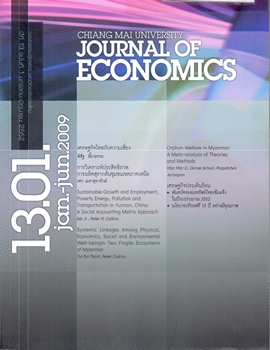Orphan Welfare in Myanmar: A Meta -analysis of Theories and Methods
บทคัดย่อ
The main objective of this study is to contribute Orphan Well-being Index (OWI) by using best fitted theories and applicable methods in the situation of Myanmar. The numbers of orphans have increased in Myanmar because of poverty and disaster. With this increasing number of orphans and poor children, the orphanages and institutions has been increased. Faith-based institutions were mainly running a number of orphanages within country. While faith-based institutions provide children food, shelter, clothes and educating. The well-being of these children under institutions are more and more important. When investigating the well-being of orphans, the data turned out to be unreliable. Therefore the methods and theories were modified to adapt to the situation of Myanmar.
Overall orphan well-being comprised of three domains of well-being, physical, emotional and educational. Physical well-being was made up of the indicators of nutritional status, accordance of accident, sickness, hunger, death rate and hospitalization. Due to the age unreliable problems of children in the real world situation, nutritional status was measured with MUAC, age independent anthropometric indicator which can be conducted easily in the field-based research and is reliable. Emotional well-being was made of the indicators of happiness at school, happiness at orphanages and relationship with peers. Educational well-being of children was measured with the indicators of scores in Myanmar reading, scores in Myanmar writing, scores on Mathematics and scores in Science. Finally, orphan well-being index was built as casual indicators models where indicators defined the domains of well-being. This orphan well-being index was built in order to investigate the differences of basic well-being of children by regions or types of orphanages in Myanmar.
ดาวน์โหลด
ฉบับ
ประเภทบทความ
สัญญาอนุญาต
All opinions and contents in the CMJE are the responsibility of the author(s). Chiang Mai University Journal of Economics reserves the copyright for all published materials. Papers may not be reproduced in any form without the written permission from Chiang Mai University Journal of Economics.
ข้อคิดเห็นที่ปรากฏและแสดงในเนื้อหาบทความต่างๆในวารสารเศรษฐศาสตร์มหาวิทยาลัยเชียงใหม่ ถือเป็นความเห็นและความรับผิดชอบโดยตรงของผู้เขียนบทความนั้นๆ มิใช่เป็นความเห็นและความรับผิดชอบใดๆของวารสารเศรษฐศาสตร์ มหาวิทยาลัยเชียงใหม่
บทความ เนื้อหา และข้อมูล ฯลฯ ในวารสารเศรษฐศาสตร์มหาวิทยาลัยเชียงใหม่ ถือเป็นลิขสิทธิ์เฉพาะของคณะเศรษฐศาสตร์มหาวิทยาลัยเชียงใหม่ หากบุคคลหรือหน่วยงานใดต้องการนำทั้งหมดหรือส่วนหนึ่งส่วนใดไปเผยแพร่ต่อหรือเพื่อกระทำการใดๆ จะต้องได้รับอนุญาตเป็นลายลักษณ์อักษร จากวารสารเศรษฐศาสตร์ มหาวิทยาลัยเชียงใหม่






